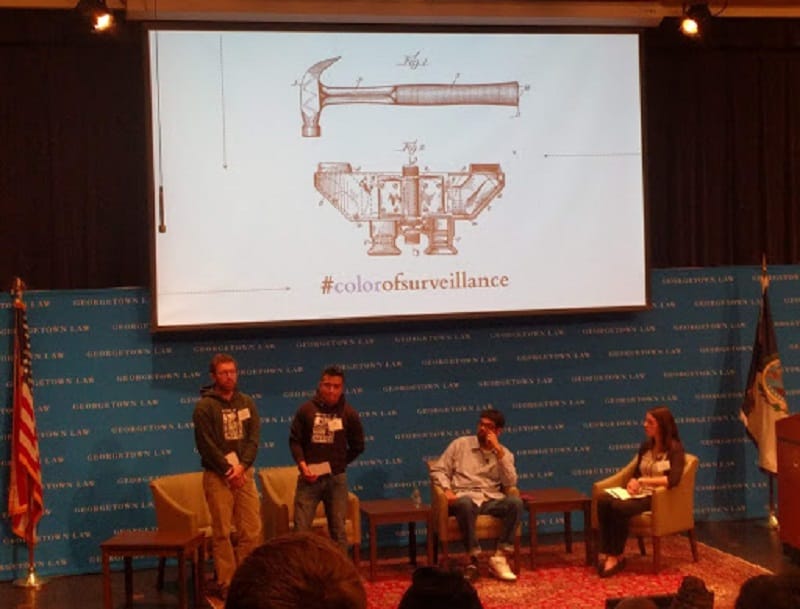As Technology Enables Employer Mass-Surveillance, Activists Say Current Privacy Laws Benefit the Wealthy
WASHINGTON, November 7, 2019 – The poor and working classes are most concerned about privacy and surveillance, yet current privacy laws ultimately benefit the wealthy, experts say at a Georgetown University Law Center Thursday. The event highlighted how marginalized groups are monitored, both physic

WASHINGTON, November 7, 2019 – The poor and working classes are most concerned about privacy and surveillance, yet current privacy laws ultimately benefit the wealthy, experts say at a Georgetown University Law Center Thursday. The event highlighted how marginalized groups are monitored, both physically and digitally.
Surveillance is key to rescinding benefits and removing eligibility for marginalized people, said Gabrielle Rejouis, associate at Georgetown Law’s Center on Privacy and Technology. Slavery, she said, formed the groundwork for modern day surveillance and class conflict.
Just as algorithms are being used to optimize peoples’ lives, Rejouis said, they are optimizing the workplace. Technology is allowing employers to access more data in a more granular and intrusive way. Furthermore, she said, employees aren’t given the chance to question or bargain about the method of surveillance.
The monitoring of poor and working people has occurred for at least hundreds of years, said Alvaro Bedoya, founding director of Georgetown Law’s Center on Privacy and Technology. The Elizabethan era “Poor Laws,” for example, implied that lower class citizens were so different that they needed to be morally regulated. Poor houses, he said, have historically been used for this purpose.
In the present day, Bedoya continued, Amazon has obtained a patent for movement-tracking wristbands for its workers, forming an unsettling precedent for on-the-job surveillance.
The Industrial Revolution of the 19th century increased poverty by as much as a third, said Michael Reisch, social justice professor at the University of Maryland. Reisch described middle and upper-class people known as “friendly visitors,” who frequented poor homes and insisted on keeping detailed records of those people’s lives.
Although the means of surveillance have become more sophisticated, he said, its underlying purpose hasn’t changed.
Poor Americans are significantly more concerned about data collection than their wealthy counterparts, said Mary Madden, research lead at the Data & Society Research Institute. The Institute’s surveys have also shown that these people are more concerned about being victims of internet fraud or online harassment.
Low-income Americans suffer from societal extremes of both hypervisibility and invisibility, Madden said. They have the most available online data, yet they are hindered by lack of accessibility to online resources.
A “one-size fits all” privacy solution, she said, cannot help all marginalized communities because they each have different circumstances. Proper safeguards and investments are needed for low-income groups to challenge societal standards.
Privacy laws aren’t written to protect poor people, said Michele Gilman, law professor at the University of Baltimore. Even the Fourth Amendment does not prevent officials from visiting welfare homes, she said, because people choosing to use public housing are considered “consenting.”
For the upper classes, Gilman said, public benefits come in the form of tax breaks. Welfare benefits, on the other hand, are considered a form of charity. As such, welfare donors feel that they have a right to witness how their money is used.
The origin of privacy legislation, Gilman continued, came from high-society figures who wanted the “right to be left alone.” Low-income citizens, however, cannot abide by this principle because they must consistently interact with the state to receive support.
Data collection is largely stigmatizing, she said. Thirty-nine percent of Internal Revenue Service audits last year were of working-class citizens. Because of this information, low-income people are targeted for predatory products and excluded from mainstream housing and public services.
Virginia Eubanks, associate professor of political science at the University of Albany, described surveillance technology as a mechanism for social control.
Not only does it automate a false notion of scarcity, she said, but monitoring of workers increases feedback loops of oppression. These feedback loops also create an “empathy override,” in which worker issues are outsourced to computer programs, so that employers don’t have to determine solutions.
Surveillance is also being used to alter working conditions, said Temple University Law Professor Brishen Rogers. Modern jobs are made up of different tasks, yet only some of these tasks can be automated.
Despite the increase in automation, Rogers said, there hasn’t been an overall higher growth in worker productivity except in warehouse facilities. Amazon, for instance, uses data driven technology to determine how quickly its workers can perform manual actions.
If there was a way for data to enhance enforcement, he said, then perhaps there is a way to alter hourly wages and other working conditions. But there are still some ways to go in that regard.
Constant, on-the-job surveillance, said Marley Pulido, director of Worker Resources and Training at Coworker.org, creates more pressure for workers to succeed and less incentive for them to complain.
Surveillance technology can be difficult for ordinary people to understand, he said, especially how it’s conducted. But the main takeaway workers get is that technology and surveillance seem to go hand-in-hand, and they don’t want to go against that principle.










Member discussion